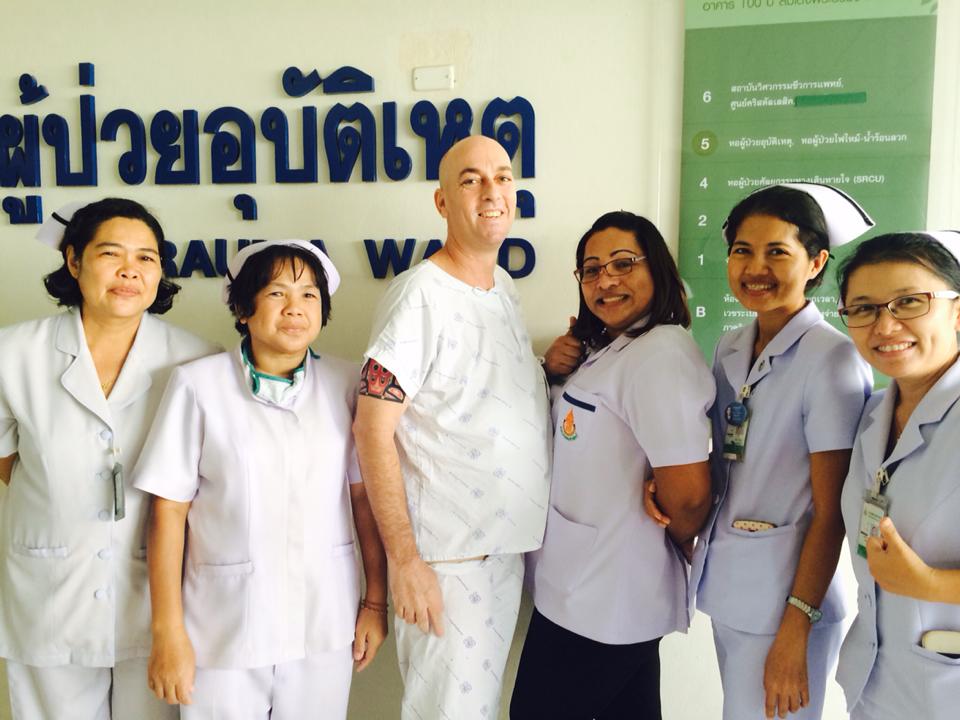One ESL Teacher Walks Countless Miles in His Students’ Shoes
Hi. How Are You?
When Americans greet each other, they usually exchange some variant of “Hi. How are you?” Although it seems like the most practical way to strike up a conversation, the phrase is not universal. In his 20 years living abroad, Buck Blankenship has observed a rich variety of greetings.
“So this is something in every culture I’ve been in, there’s different ways of connecting,” Buck explains. “In Japan, they usually ask how’s the weather? In Thailand, they ask have you eaten yet? And if you haven’t eaten yet, they take you to get something to eat!”
In fact, Buck arrived late to teach is first English as a Second Language class in Thailand because he answered no when his supervisor greeted him with this question. Schedules be darned! The students could wait. Hospitality demanded that Buck be taken to get a proper meal.
Ecuador, Saudi Arabia, Spain. Buck has taught in or traveled to dozens of countries around the world. His exposure to diverse cultures, customs, fashion, laws, and languages has cultivated a deep sense of resonance with the students in his ESL classes at the Durango Adult Education Center.
“I think I empathize more with the students here,” he muses. “I relate it to a fishbowl. When I was abroad, I was outside the bowl looking in, wondering what the heck is happening in there! And now I’m in the fishbowl looking out.”
Translation is a central facet of his role as a language instructor. Students not only need words deciphered, but also customs, behaviors, rules, taxes, holidays, and local events. Unraveling these riddles enables students to venture out, make connections, earn an income, or interact with their children’s school teachers.
In Buck’s experience, language is a lifeline. “As you speak the language, you can have an understanding or be brought into culture more,” he notes. The more he could communicate, the more he could participate in everything from festivals to funerals.
In addition to possessing superb translation skills, Buck believes all ESL teachers could also benefit from having some culinary skills stashed in their back pocket.
Passing Down Recipes
Before he was a teacher, Buck worked as a chef. As a boy, he watched his grandmother stir giant pots of sauce and pasta. When she wasn’t cooking Sunday dinner for the entire extended family, she was cooking in her brother’s New York restaurant.
Buck recalls with a chuckle, “She had these huge pots and she was this little four-foot-eleven Sicilian woman. She was fun and interesting! She cussed all the time! She learned English from the Bible, but she cussed like a sailor.”
Buck started his cooking career as a bus boy. As he worked his way up through the kitchen ranks, he met many immigrants from across Mexico and South America. “These people will tell you their stories. They walked hundreds of miles or they boarded some sketchy bus. The stories…some of them are not pretty. Knowing people’s stories is part of the whole reason why I got into teaching. Sharing stories. This passing on of knowledge. It’s like passing down recipes.”
Across the world’s classrooms, Buck has utilized this culinary listening. Students shared heart-wrenching and horrific personal stories of escaping wars or genocides in Cambodia, Eritrea, Ethiopia, or Burma. Buck realized that regardless of what pulled someone far away from home, every person wants to feel welcome, provide for themselves and their families, and live a rich life.
And he also discovered the dark was always balanced by plenty of light—as in the comedic levity of being a culturally clumsy foreigner.
Gaijin! Farang! Gringo!
Alien. Other. Outsider. People openly branded Buck with these labels in every country. How could they not? Standing a foot or more above everyone else, he literally stuck out. He was clearly a different color, too.
However, as time passed, and he embedded deeper into the community and culture, his differences became endearing. He became something of a local celebrity. Everyone knew him or knew of him. He was something of a gem. And best of all, the most far-flung villages in Asia, the Middle East, or South America could proudly boast having their very own giant Santa Claus!
Being branded with an unfriendly label is yet another experience Buck shares with his ESL students in Durango. Despite the town’s innately welcoming culture, immigrant students do report harassment and insults directed at their “otherness.” Buck speculates that while some individuals will achieve genuine acceptance in their community, others might never be fully embraced. Sometimes, there really is no place like home. Or in other words, not everyone gets to be the local Santa.
Now that he’s one among millions of giant, jolly Santa-types strolling U.S. streets, Buck has realized sticking out in a foreign place is somehow easier than blending in at home. Luckily, there’s a lot about life in Durango that reminds him of life abroad. The nearby desert landscapes look exactly like Saudi Arabia. There’s even a local perhaps “Wild West” tendency to shrug of rules or treat them as suggestions that echoes the culture in Thailand.
 Japan, like Durango, emphasizes active outdoor lifestyles, relaxing in hot springs, and recreating in the mountains year-round. And in the village where Buck lived, there was also a severe shortage of locked doors. Specifically, all the houses had a foyer or mudroom—a place for shoes to be removed and stored before entering the actual inner abode. Neighbors also used this room to drop off gifts, especially excess garden bounty. Buck relished coming home, sliding the door open, and discovering daikon or bundles of greens.
Japan, like Durango, emphasizes active outdoor lifestyles, relaxing in hot springs, and recreating in the mountains year-round. And in the village where Buck lived, there was also a severe shortage of locked doors. Specifically, all the houses had a foyer or mudroom—a place for shoes to be removed and stored before entering the actual inner abode. Neighbors also used this room to drop off gifts, especially excess garden bounty. Buck relished coming home, sliding the door open, and discovering daikon or bundles of greens.
Buck also feels a deep sense of resonance within the Durango Adult Education Center. “The way that they do things [at the DAEC] is very deliberate and thoughtful” he says, noting how local officials from different resource centers visit the classrooms to educate students about what is available to them, or what their rights are, or where to go when they need x, y, or z. “There’s unique little pieces to our program that other programs don’t have.”
Dedicated classrooms are a prime example. Elsewhere in the world, a classroom might be an airplane hangar or some other old building repurposed into a temporary classroom. At the Cortez and Durango locations, students have access to a bona fide learning center with work tables, comfortable chairs, whiteboards, projectors, even laptops they can check out.
There’s also a functioning kitchen stocked with food for students. Hot meals are delivered daily. Buck thoroughly enjoys connecting over meals with students and other AEC teachers. He feels very much at home with his fellow teachers. “The people that I’m working with, they’re definitely the same birds of a feather. They’re on the same wavelength as me. Everyone is supportive and nice.”
For Buck and his students, the DAEC is a place they can feel in harmony with others. Anyone can share their stories, or pass down their recipes. Acceptance. Appreciation. Even a dash of Santa célébrité. These sensations are not uncommon at this caring learning center. When there’s no place like home, there is the Adult Education Center, a home away from home.








